
It’s summer time for my daughter, and so far, the bulk of her time has gone to a particular activity: the creation of “slime.”
It began about six weeks ago, when we were talking about what she wanted to do for her birthday. Simple—she wanted to have a few friends over to spend the afternoon creating slime.
“Who would want to spend the afternoon doing that?” I asked.
“Everyone!” she replied.
Still doubtful, I started texting the mothers of her friends. Sure enough, though none of the mothers understood it either, their daughters were all eager and set for a slime date. As she predicted, the girls had a great time creating different-colored slime all afternoon.
The first time she mentioned “slime,” I thought of the usual dirty, thick, sticky substance found in damp and dark cabinets. I wasn’t too far off the mark, it turned out.
It’s not dirty. It’s not edible either, but as it’s usually homemade, the ingredients are the same items we use regularly. It is thick and gooey, but it’s not necessarily sticky.
Sometimes slime is made to be “fluffy.” Other times, it has little beads and balls. There are also butter slime, clear slime and glitter slime. And don’t forget Galaxy and Unicorn slime. And, of course, scented slime.
The list seemed endless.
How-to videos
I’m not sure what the appeal is, but judging from the amount of slime creation and “how-to” videos, accounts and photos posted online, it seems quite a number of people, not just children, are hooked on this trend.
It seems the majority who order slime seem to enjoy its “therapeutic effect.”
These days, stress balls, fidget spinners (don’t even get me started on those!) and now, slime, seem to have found a place on the market as a way of fighting stress.
Slime—from its appearance to the sensation it provides, as it is folded and kneaded, and even the sound it makes as it is folded, or its air bubbles popping and the scent it releases (for the scented slime variety)—is the new stress absorber of choice.
Especially now, with many people, young and old, having less physical activities, there’s just too much pent-up energy that needs to be released, and with tiny, pocket-size stress balls and cans of slime, it can be done anywhere, anytime.
Perhaps the texture, so different from the screens and keyboards many of us are exposed to, is novel and amusing.
For the enterprising, slime is an opportunity to earn extra money—a small batch of slime is sold online for anywhere from P20 to P150.
When I asked my 9-year-old daughter and her friends exactly why they enjoy playing with slime, none of the aforementioned explanations was even mentioned.
“It’s fun!” was the overwhelming response. And come to think of it, why wouldn’t it be?
The colors, the texture and the extra characteristics were just the thing to help the kids channel their creative juices and keep them off the screens .
And due to the temporal nature of the slime—it eventually loses its ability to stretch, and hardens into a thick mass—as long as there were ingredients, there was always a reason to create a new batch.
Glue and colors
I watched the girls go crazy mixing glue and colors together and creating one batch of slime after another, but not without being on hand with a Ziploc bag to immediately store it in—lest it become a permanent blotch on my couch or carpet.
Most recipes call for Borax, a mineral compound used for laundry and available in the United States but not locally. I’m not actually familiar with Borax and how safe it is.
Fortunately, it’s easy to make slime even without Borax. Here is the girls’ slime recipe for some super slime!
Slime
1 c Elmer’s White Glue
1 c shaving cream
1 tbsp cornstarch
A few drops of food coloring
A few drops of contact lens solution
4 tbsp liquid fabric detergent
Optional: lotion (for scent)
Add the glue and shaving cream first. Slowly mix in the cornstarch and after, mix in the liquid fabric detergent.
The detergent will change the consistency of the glue mixture and begin to form the slime. You will have to keep mixing and eventually, start kneading continuously with your hands to get the correct consistency.
It will start off as extremely sticky, but after several minutes of continuous kneading, will eventually turn into normal slime.
It takes a little practice to get the hang of it, but once your kids get it—and believe me, they will—you might find slime all over your house.
It helps to know that it can be removed with soap, water and a lot of patience. I have also been told that it gets off with vinegar, though I have yet to try it.
In the meantime, keep a number of Ziploc bags ready to keep them off your furniture!

